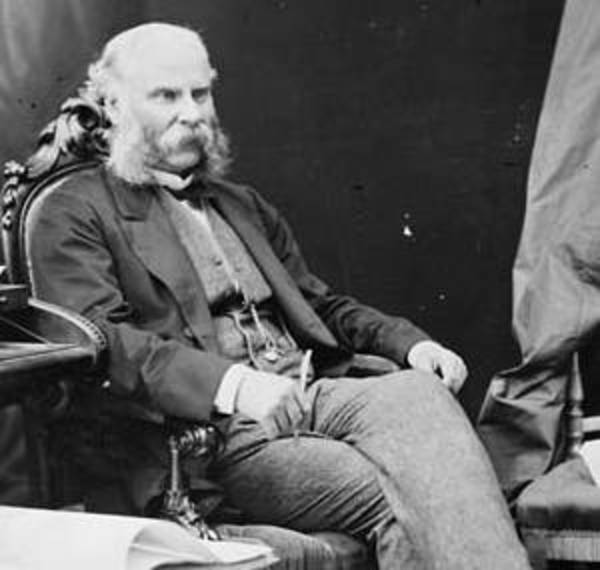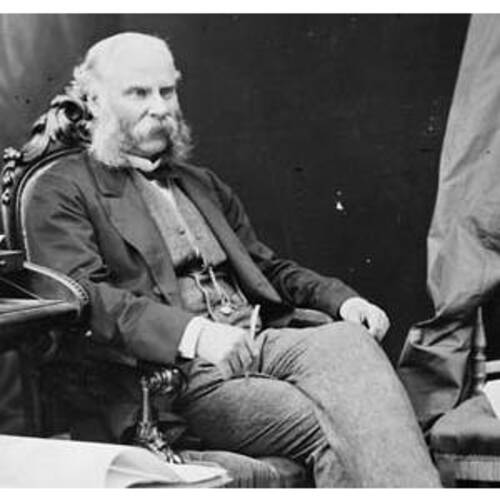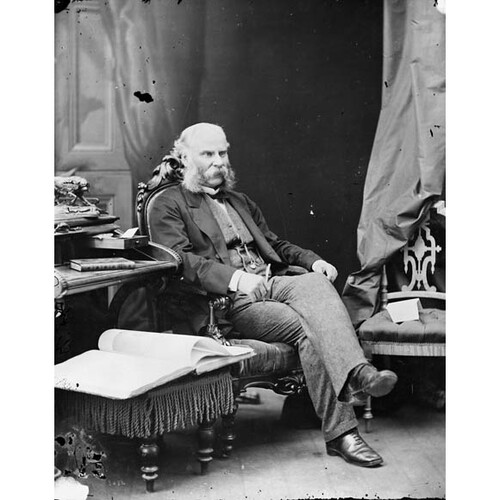
Source: Courtesy of Wikimedia Commons
GIBBS, THOMAS NICHOLSON, miller, merchant, manufacturer, banker, and politician; b. 11 March 1821 at Terrebonne, Lower Canada, the eldest son of Thomas Gibbs and Caroline Tate; m. in August 1843 Almira Ash, and they had seven children; d. 7 April 1883 at Oshawa, Ont.
Thomas Nicholson Gibbs was educated in Lower Canada and also in England at a school run by his uncle. In 1832 the family moved to Oshawa, Upper Canada, where Thomas Gibbs entered the grain and produce business. Two of his sons, Thomas Nicholson and William Henry, formed the firm of Gibbs and Brother in 1842 and built a grist-mill south of Oshawa. To this business were soon added fulling-, oatmeal, and barley mills, a distillery, and a tannery; Gibbs and Brother quickly became large-scale exporters of grain and produce. When their chief milling competitor, John B. Warren, failed, the two brothers took over his mill in 1865, thereby consolidating their local dominance in the grain and milling trade.
In 1852, in partnership with Oshawa and Montreal businessmen including Abram Farewell, Gibbs became a major investor in and director of the Oshawa Manufacturing Company, a maker of agricultural implements capitalized at $75,000. The firm, headed by an American, Algernon Sidney Whiting, employed New England craftsmen brought to Oshawa. The company declared bankruptcy in 1858. Ten years later the brothers purchased the Oshawa Cabinet Company from the estate of Edward Miall, its founder. This firm was operated separately from Gibbs and Brother, with Thomas as president. He was intensely disliked by his employees because of his harsh labour practices in such matters as suspensions, firings, and forced voting in municipal and provincial elections. In the federal election campaign of 1872, one of the Oshawa company’s men, James Brown, on the basis of his working experience, fought hard to prevent an alliance in Ontario between labour and the Conservatives, the party for which Gibbs was standing. Letters opposing the alliance that appeared in the Ontario Workman and the Oshawa Vindicator under the pseudonym Heather Jack were actually written by Brown.
Because the grain trade required access to large amounts of credit, Gibbs joined the consortium of millers, including Farewell and James Gooderham Worts, which founded the Bank of Toronto in 1855. Henceforth he would become deeply involved in banking and finance. When the Ontario Bank was being sponsored by John Simpson of Bowmanville in 1857, Gibbs was both an incorporator and an early investor, and served as director and vice-president. The economic boom of the early 1870s marked the apex of Gibbs’s fortunes. In 1871 he was an incorporator and director of both the Confederation Life Association and the Dominion Telegraph Company. Two years later, in cooperation with other Oshawa businessmen, he founded the Ontario Loan and Savings Company and he was named president in 1874. The following year the directors of the St Lawrence Bank (incorporated in 1872) elected Gibbs president, hoping that he could stave off its impending collapse. Although the other banks in Toronto refused assistance, Gibbs used his political connections with Sir John A. Macdonald* to obtain a loan of $150,000 from the Bank of Montreal, and the St Lawrence Bank survived the crisis. Renamed the Standard Bank of Canada in 1876, and with a greatly reduced capital, it eventually prospered; in 1880 Gibbs owned $30,000 worth of shares. With his associates in the Ontario Loan and Savings Company Gibbs founded the Western Bank of Canada, based in Oshawa, in 1882. In addition to these business interests, he was a lifelong director of the Sydenham Harbour Company (its name was changed in 1878 to the Oshawa Harbour Company), which had been founded by his father, and was chairman of the Canadian board of the London and Canadian Loan and Agency Company and also of the English and Scottish Investment Company of Canada. The firm of Gibbs and Brother failed in 1878 after an unsuccessful foray into speculation in barley, but the other Gibbs enterprises continued to prosper and in 1880 the Oshawa Cabinet Company, with sales of $167,000, employed 125 men.
As Oshawa’s chief businessman and financier, Gibbs dominated local politics in the 1850s and 1860s. He held few abstract philosophical theories, but rather saw politics as an extension of his business interests In the 1850s he was described as a moderate Reformer by local Conservatives, but after confederation was clearly identified as a supporter of Sir John A. Macdonald. Gibbs had begun his public career in 1850 when he was elected the first reeve of the village of Oshawa. He retained that office until 1854 and won it again in 1857. As Oshawa’s representative to the council of the united counties of York, Ontario, and Peel, he vigorously opposed their separation because of the expense that would be involved as well as the likelihood that Whitby, and not Oshawa, would be named the county town of Ontario County. Once separation became inevitable, however, he threw his support behind it, and in 1854 was named the first warden. In the general election held that same year he contested Ontario North as a Reformer but ran third to Joseph Gould and Ogle Robert Gowan*.
When a by-election was called in Ontario South after Oliver Mowat*, the Liberal incumbent, was appointed vice-chancellor of the Court of Chancery in Canada West in 1864, local Conservatives backed Gibbs as a moderate Reformer against Farewell, a radical Grit. Gibbs’s correspondence with Macdonald makes it clear that his narrow victory was won by large-scale vote buying and patronage. In the federal election of 1867 Gibbs fought the most notable campaign of his career. Local Reformers nominated George Brown*, while Gibbs was backed by the Conservatives and the John Sandfield Macdonald* “Bureaucratic Liberals.” Again Gibbs won by corrupt practices. With Brown’s narrow defeat the way was opened for Alexander Mackenzie* to assume the leadership of the federal Liberal party. Because Gibbs was the only successful Conservative candidate in the area, he became Sir John A. Macdonald’s confidant and “fixer” in dealings with Toronto capitalists such as William Gooderham Sr as well as during the Canadian Pacific Railway negotiations held in the city.
As a legislator, Gibbs made few contributions. When he spoke it was generally on the practical aspects of banking or tariffs. Although he initially had supported the principle of reciprocity, the abrogation of the treaty in 1866 and the acquisition of the Oshawa Cabinet Company two years later changed his perspectives and he now favoured retaliatory tariffs and protection for manufacturers. On 14 June 1873 Sir John A. Macdonald named Gibbs secretary of state for the provinces and superintendent general of Indian affairs. He was moved to the Department of Inland Revenue on 1 July 1873 but the Pacific Scandal and the defeat of Macdonald’s government on 6 Nov. 1873 ended his cabinet career almost before it had begun. Gibbs had been re-elected in the general election of 1872 and again in the by-election necessitated by his elevation to the cabinet on 14 June 1873. Defeated in 1874 by Malcolm Cameron*, he was returned in 1876 after Cameron’s death necessitated another by-election. He lost his seat in the general election of 1878 but two years later was appointed to the Senate.
PAC, MG 24, B30, 2: 1108, 1115; B40, 7: 1610–24; 8: 1852; MG 26, A. United Counties of York, Ontario, and Peel, Municipal Council, Minutes ([Toronto]), 1853. Canadian Statesman (Bowmanville, Ont.), 6 June 1872. Globe, 4, 7 Sept. 1874. Mail, 2 Sept. 1874. Monetary Times, 3, 24 Sept. 1868. North Ontario Observer and General Advertiser (Port Perry, Ont.), 12 April 1883. Ontario Observer (Prince Albert, Ont.), 26 July 1866; 20 June, 25 July, 1, 29 Aug. 1867; 4 July 1868; 29 June, 6 July 1871; 16 Aug. 1872; 19 June 1873. Ontario Workman (Toronto), 11 July, 1 Aug., 21 Nov., 12 Dec. 1872; 16 Jan. 1873. Oshawa Reformer (Oshawa, Ont.), 21 June 1872; 14 March, 2, 9 July 1873; 28 Jan., 6 Feb., 31 July 1874; 12, 19 Feb., 14 May 1875; 7 Jan., 10 March, 14 April, 7 July 1876; 20 Sept., 4 Oct. 1878; 28 March, 6 June 1879; 13 Feb., 15 Oct. 1880. Oshawa Vindicator (Oshawa), 23 June 1858; 3 July, 7, 28 Aug., 4 Sept. 1867; 3, 10 Oct. 1894. Whitby Chronicle (Whitby, Ont.), 20 June 1867; 20, 27 Feb. 1873; 18 June 1874. Canada, an encyclopædia (Hopkins), I: 281. Canadian biog. dict., I: 295–96. J. E. [C.] Farewell, County of Ontario; short notes as to the early settlement and progress of the county . . . (Belleville, Ont., 1973; first pub. with: Ontario County, By-laws of the council . . . (Whitby, 1907), 74–75, 77. W. H. Higgins, The life and times of Joseph Gould . . . (Toronto, 1887; repr. Belleville, Ont., 1972), 126, 139, 163, 166–87, 191–212, 263–65, 267–68, 271–72. M. M. Hood, Oshawa . . . a history of “Canada’s motor city” (Oshawa, 1968), 57, 64–65, 69, 71–72, 75, 83–84, 87–92, 96–97, 109. L. A. Johnson, History of the county of Ontario, 1615–1875 (Whitby, 1973), 92, 135, 142, 147–48, 180–87, 191, 211, 226, 237, 239, 247–50, 328, 335–36. V. Ross and Trigge, Hist. of Canadian Bank of Commerce, III: 205–6, 223–31, 297, 306–7.
Cite This Article
Leo A. Johnson, “GIBBS, THOMAS NICHOLSON,” in Dictionary of Canadian Biography, vol. 11, University of Toronto/Université Laval, 2003–, accessed November 7, 2024, https://www.biographi.ca/en/bio/gibbs_thomas_nicholson_11E.html.
The citation above shows the format for footnotes and endnotes according to the Chicago manual of style (16th edition). Information to be used in other citation formats:
| Permalink: | https://www.biographi.ca/en/bio/gibbs_thomas_nicholson_11E.html |
| Author of Article: | Leo A. Johnson |
| Title of Article: | GIBBS, THOMAS NICHOLSON |
| Publication Name: | Dictionary of Canadian Biography, vol. 11 |
| Publisher: | University of Toronto/Université Laval |
| Year of publication: | 1982 |
| Year of revision: | 1982 |
| Access Date: | November 7, 2024 |




